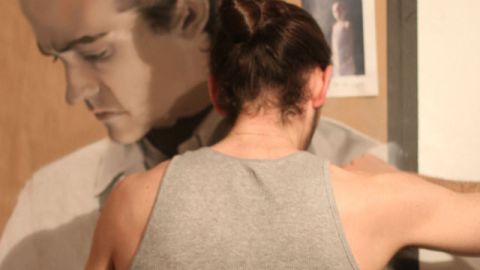A Search for Tranquility Turns into a Gallery Opening

“Lucien Freud said if you’re painting humans you have the best subject matter in the world. It’s so true. That’s the concept of [my] work. Everything has humanity in it,” says Justin Stutzman, quite possibly the world’s most talented reluctant artist. In fact, Stutzman was discovered serendipitously, and even then, he had to be hounded for over a year.
Now his art fills New York’s Salon 2B, turning the sprawling private gallery into a shrine to tranquility. A giant beckoning hand in stone. A mysterious imprint at the top of a long sheet of plaster gives the effect of a gothic ceiling in an ancient cathedral. An enormous enigmatic self-portrait done in pastel stares at you and away from you. The work is both stunning and soothing. The show closes June 17.
Gallery owner and curator Daniel Rechelbacher discovered Stutzman by chance. His close friend Vera is Justin’s neighbor in Bushwick, Brooklyn. Sitting out on her deck one day, Rechelbacher glanced at her neighbor’s apartment, and through the window saw Stutzman working on his cryptic large self-portrait in pastel. “Every time I’d go over there, I’d peek through his window and see the work progress,” says Rechelbacher. “I would usually stay and have a couple extra beers on her deck until I knew he was coming home. Then I’d knock on his door and say, hey, I saw your work, let me in.” This continued for a year and a half.
Rechelbacher and his wife Zhanna Franks, a dancer and choreographer currently performing in Sleep No More, run a safe haven for up-and-coming artists. They consider Salon 2B—their gallery, home, and critically acclaimed hair salon—a launching pad for artists.
“I started this in 2005 with the idea that we would do solo exhibitions for underexposed artists. And the idea that we would be a springboard gallery, with the hopes that they would be seen and get picked up by bigger galleries eventually,” says Rechelbacher. “We have had a number of people who don’t want to go and love what we’re doing, the intimacy.” The gallery produces a new show every three months, and has had over 50 shows that in recent years have attracted curators from The Whitney, MoMA, and The Met.
“The work has to speak to me,” says Rechelbacher. “I don’t have an art history degree. For me to curate, [the art] somehow has to make me think about a part of myself that I haven’t in a while, or bring out something in me that I don’t want to necessarily think about. That’s the job of art. To make you reflect.”
The job of art, for Stutzman, is to help him relax and process the hectic energy of living in New York. A native of Indiana, Stutzman is one of nine children homeschooled until high school began. There, art was just an “easy A,” he says. He never took it seriously. Only recently, around the time Rechelbacher spotted him, he started making things for himself, for fun.
“Who am I to make art,’ I told that to Daniel,” recalls Stutzman. “That’s what [my work] was—a solution, a coping mechanism. In an odd sense it has tranquility in it which is what I was searching for.”
His incredible skills developed out of old fashioned sibling rivalry. And helping his father, a dry wall finisher who taught him how to work with his hands. But for fun, Stutzman and his brothers and sisters would sketch. “That was our means of competition: who had the better sketch book,” he says. “We had an older brother who was just incredible and everyone aspired to capture a moment of what he had in his sketchbooks.” It was just something they did as kids.
No one in his family knew about his recently acquired passion for making art. They all came out for the opening reception on May 9. It was the first time he saw his father choke up.
One of Stutzman’s earliest supporters of his art is Chado Ralph Rucci, a living legend in fashion. If you want to see his work, Google “perfection.” (Attention Google engineers, that’s not a bad idea for an algorithm.) What Martha Stewart is to crafts and Michelle Obama is to likability, Chado Ralph Rucci is to haute couture. He was the only American designer in over 60 years to be invited by the French Chambre Syndicale de la Haute Couture to show in Paris. Stutzman is responsible for his production—caring for every single raved about stitch.
“Ralph saw one of the early pieces. ‘That’s what you are, you have to do that.’ That was amazing to hear him say that,” says Stutzman.
When asked if his work in fashion serves his art, he says, “What I do like is the execution of a garment. I make sure things are made right.” Rechelbacher believes that this training gave Stutzman the valuable skill of knowing when a work of art is finished: “Artists work on a piece to death and don’t know when it’s done. What was hanging with a question mark now is answered and wrapped with a pretty bow. Presenting something. Really great art is all about asking questions and not telling you what you should think.”
Though he works for one of the most in-demand designers in the world, Stutzman finds time to “make things,” as he calls it. He wakes up at 2:30am and works until 7:30am. “Mornings are amazing. I realize I’m in the groove when you have it on Pandora and it stops and you don’t realize it,” he says. Mornings help him work from his subconscious. And so does a message to himself that he scribbled all over his walls.
“As soon as you start treating it as special, that’s when you lost it. I have that written all over my walls,” says Stutzman. “That stops the subconscious from working. If you can’t move through a piece, I don’t think the piece has anything to say. I don’t think it came from anywhere.”
To see his work, visit his website:





